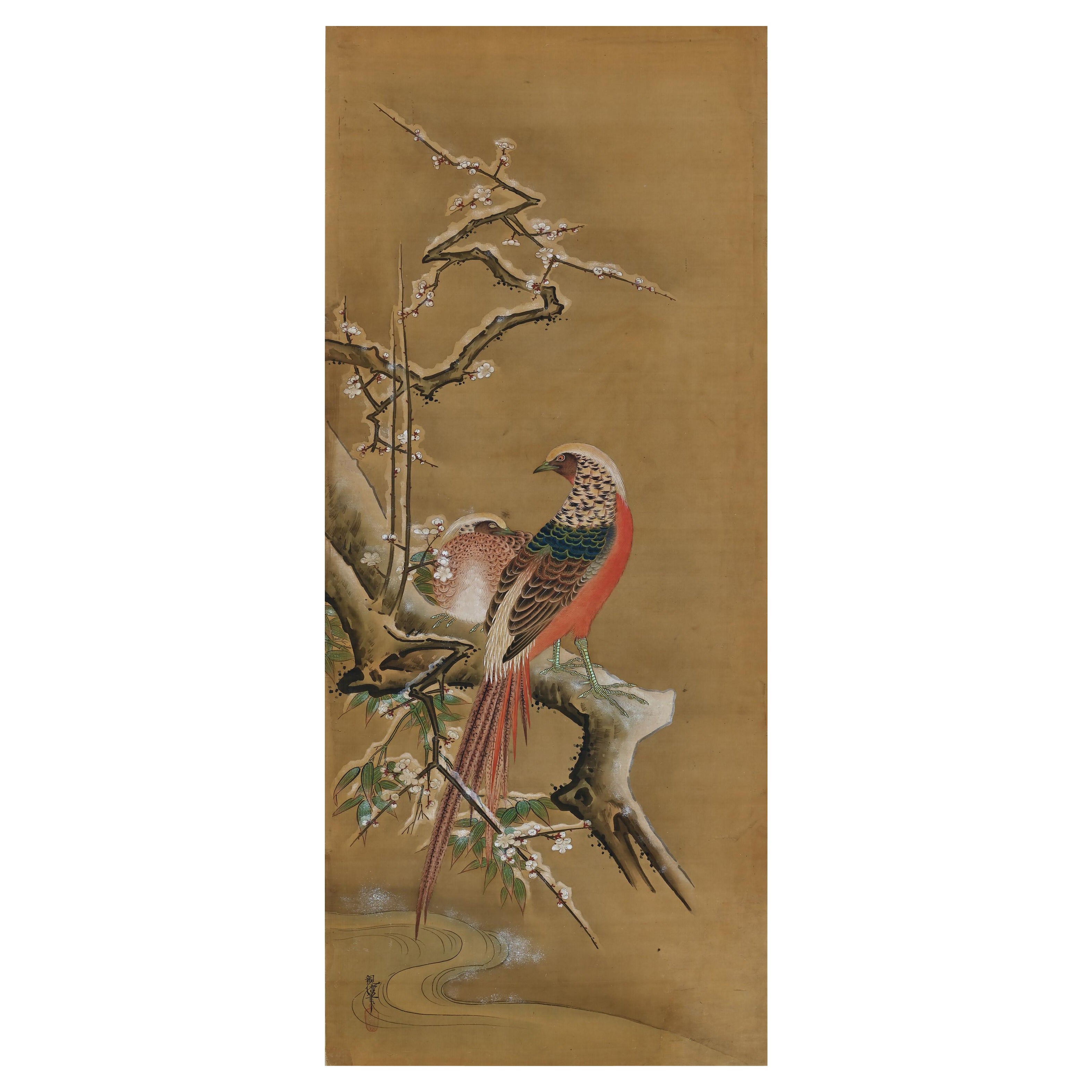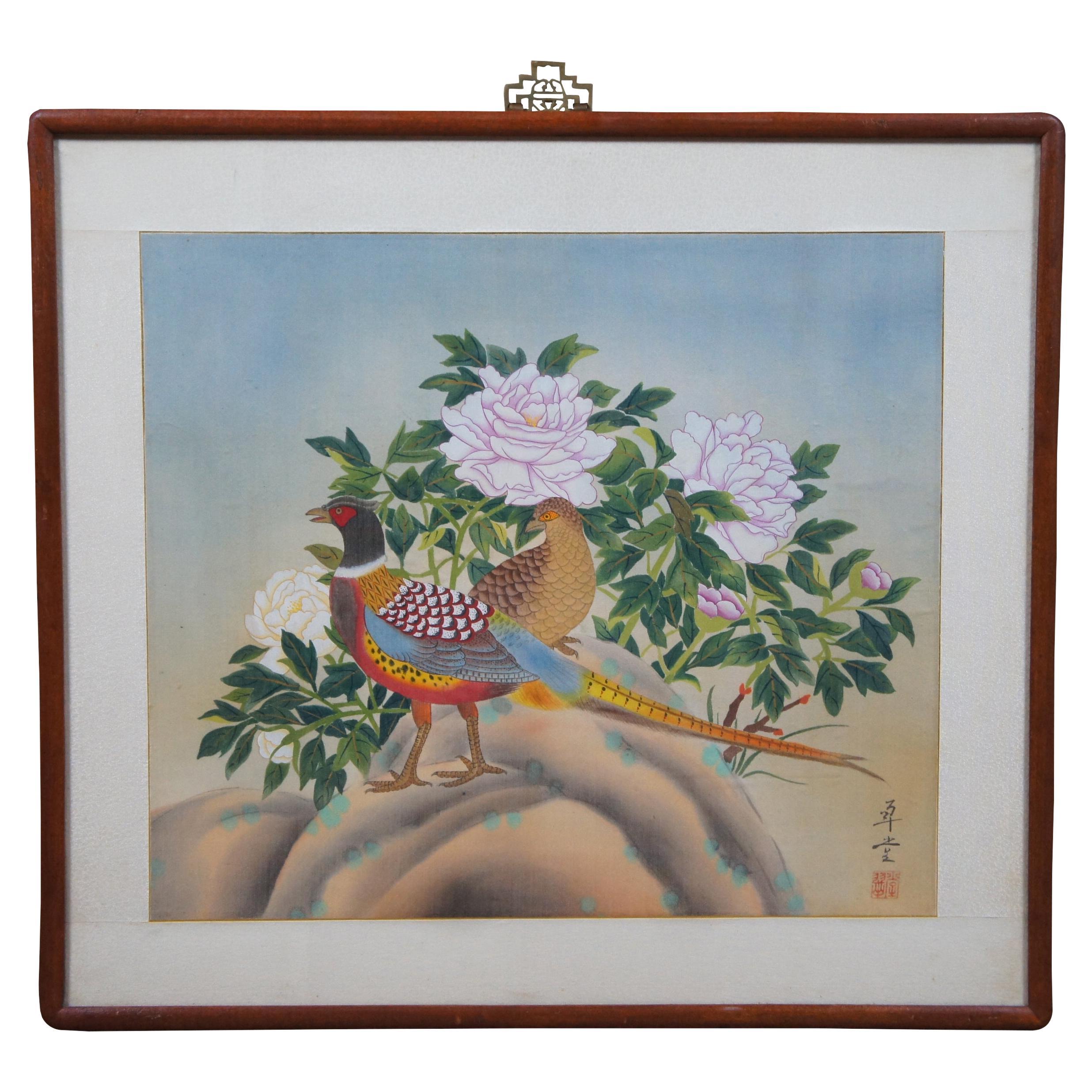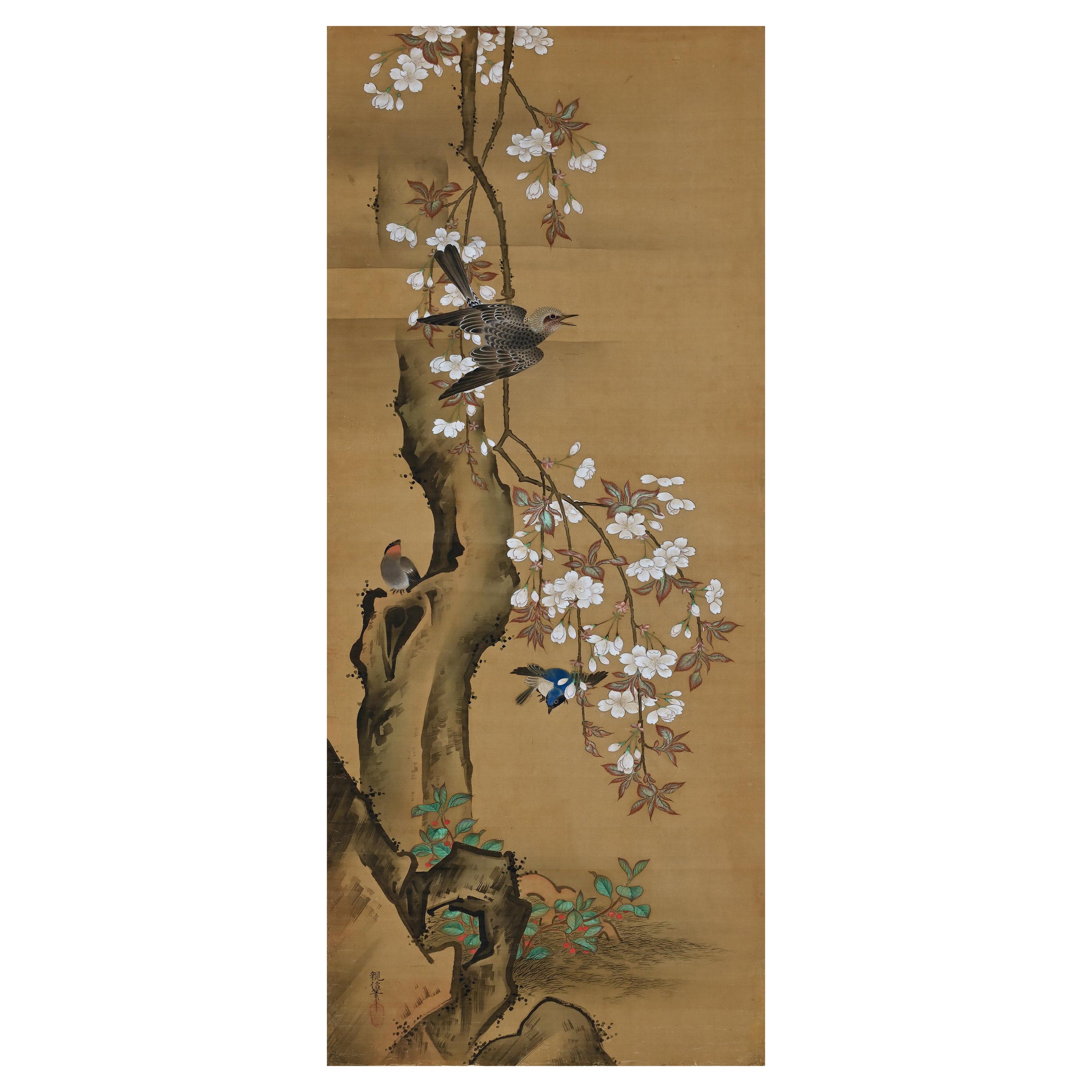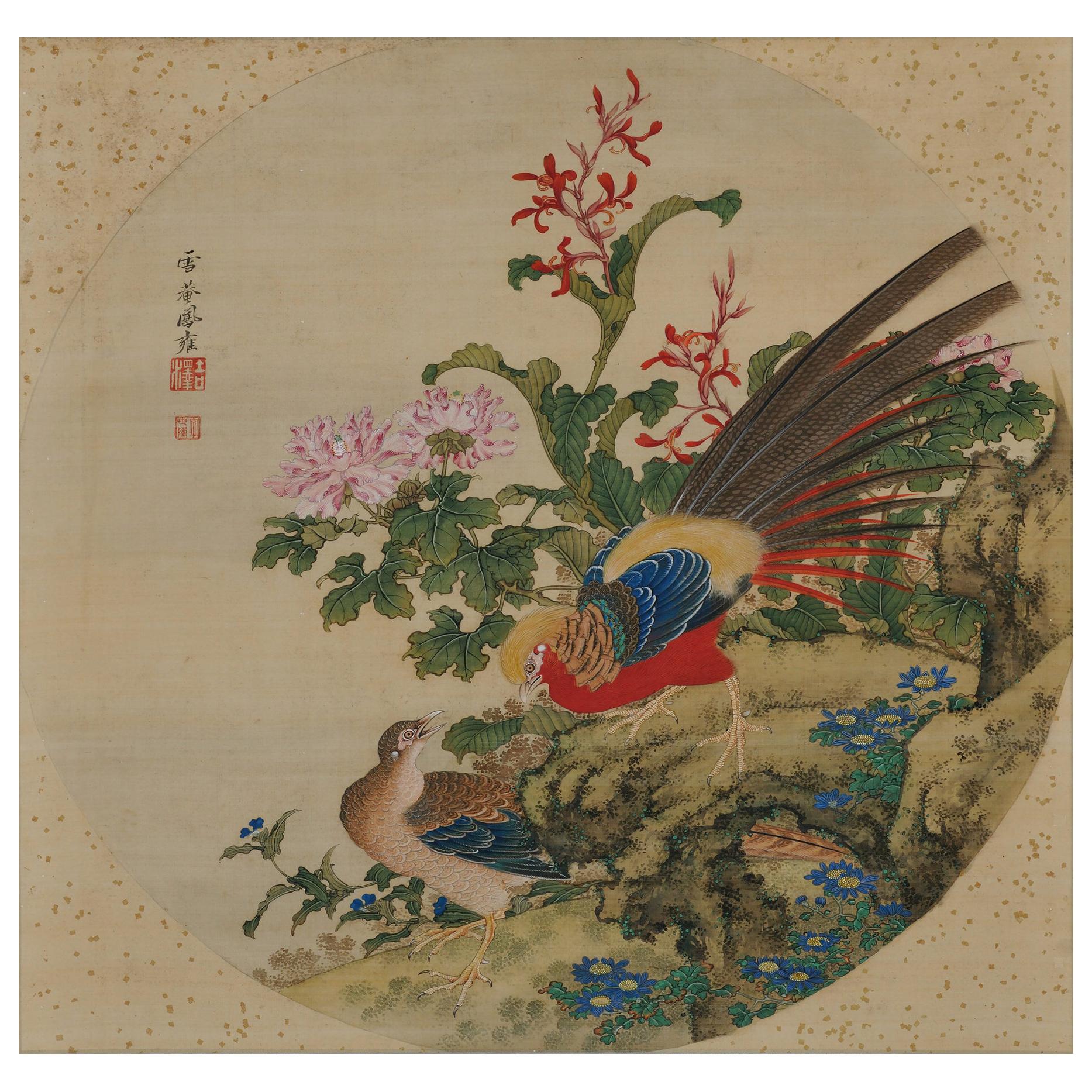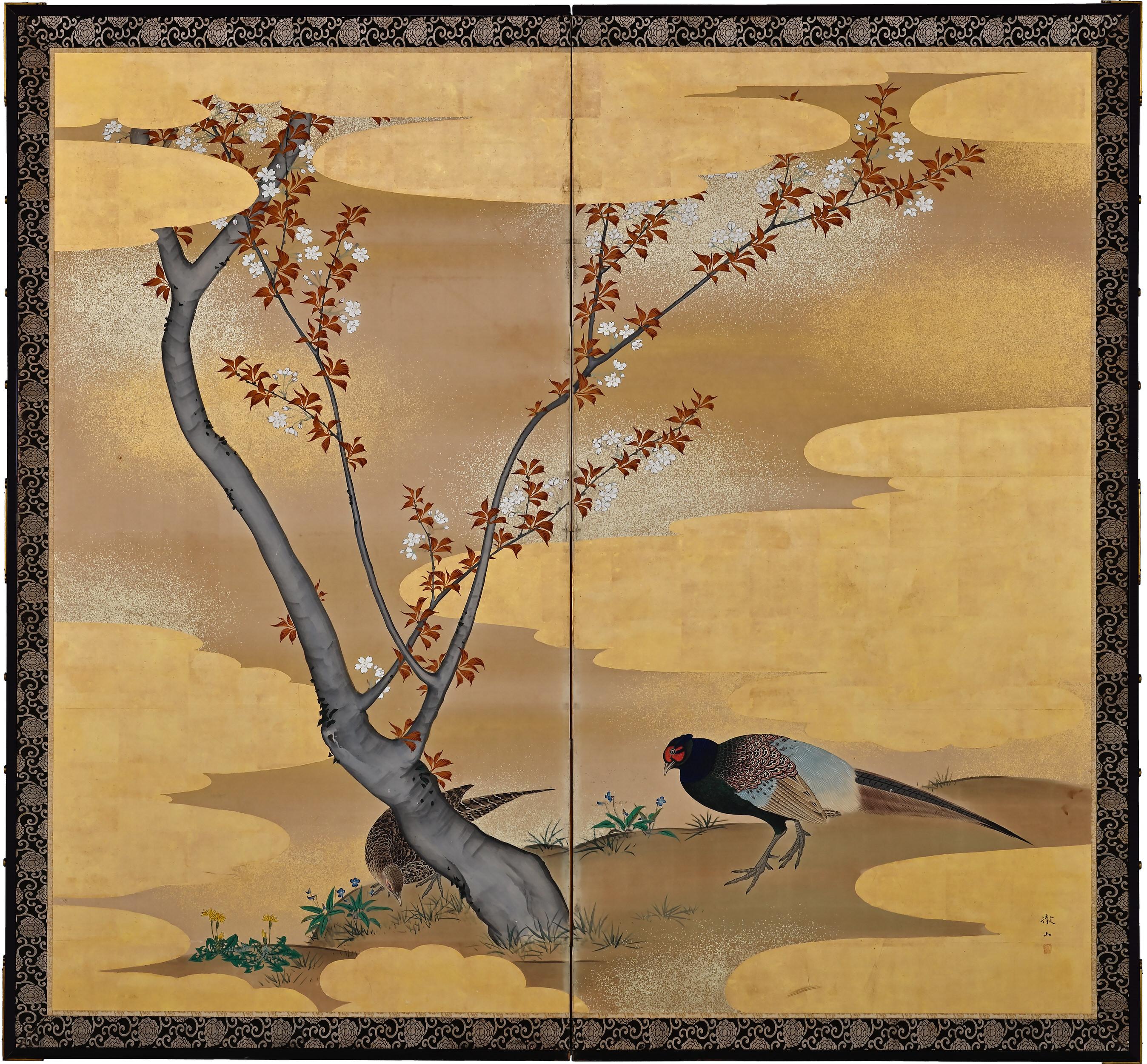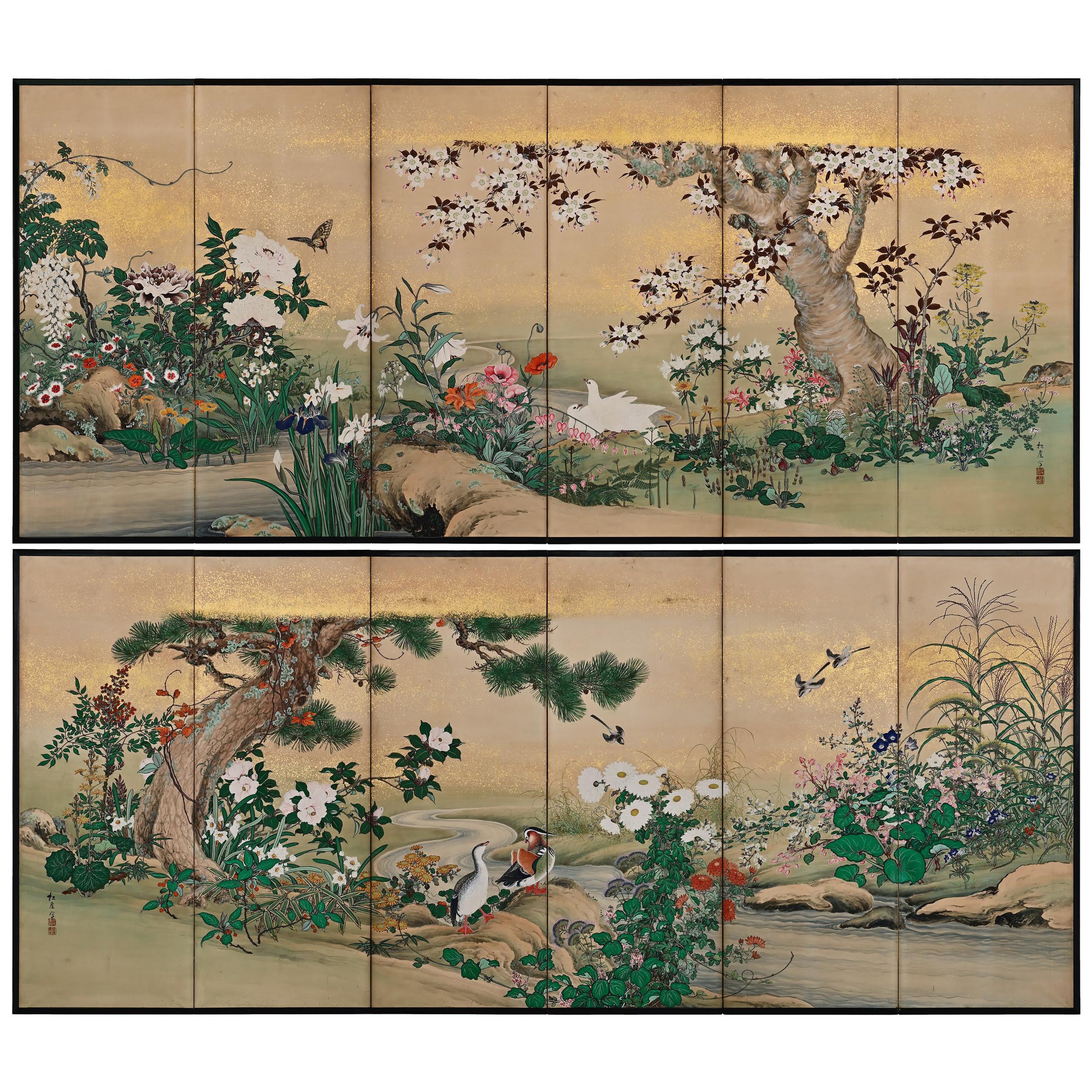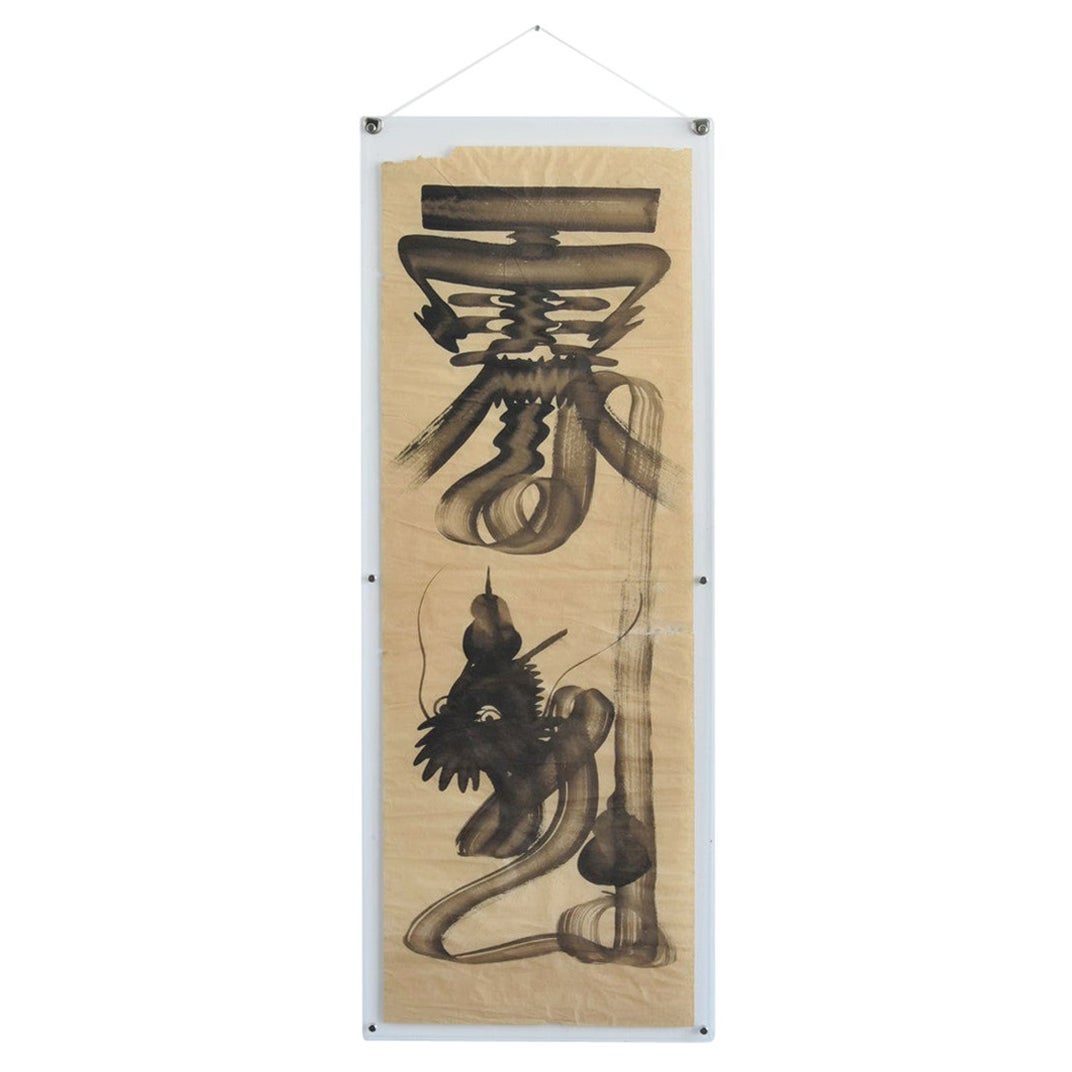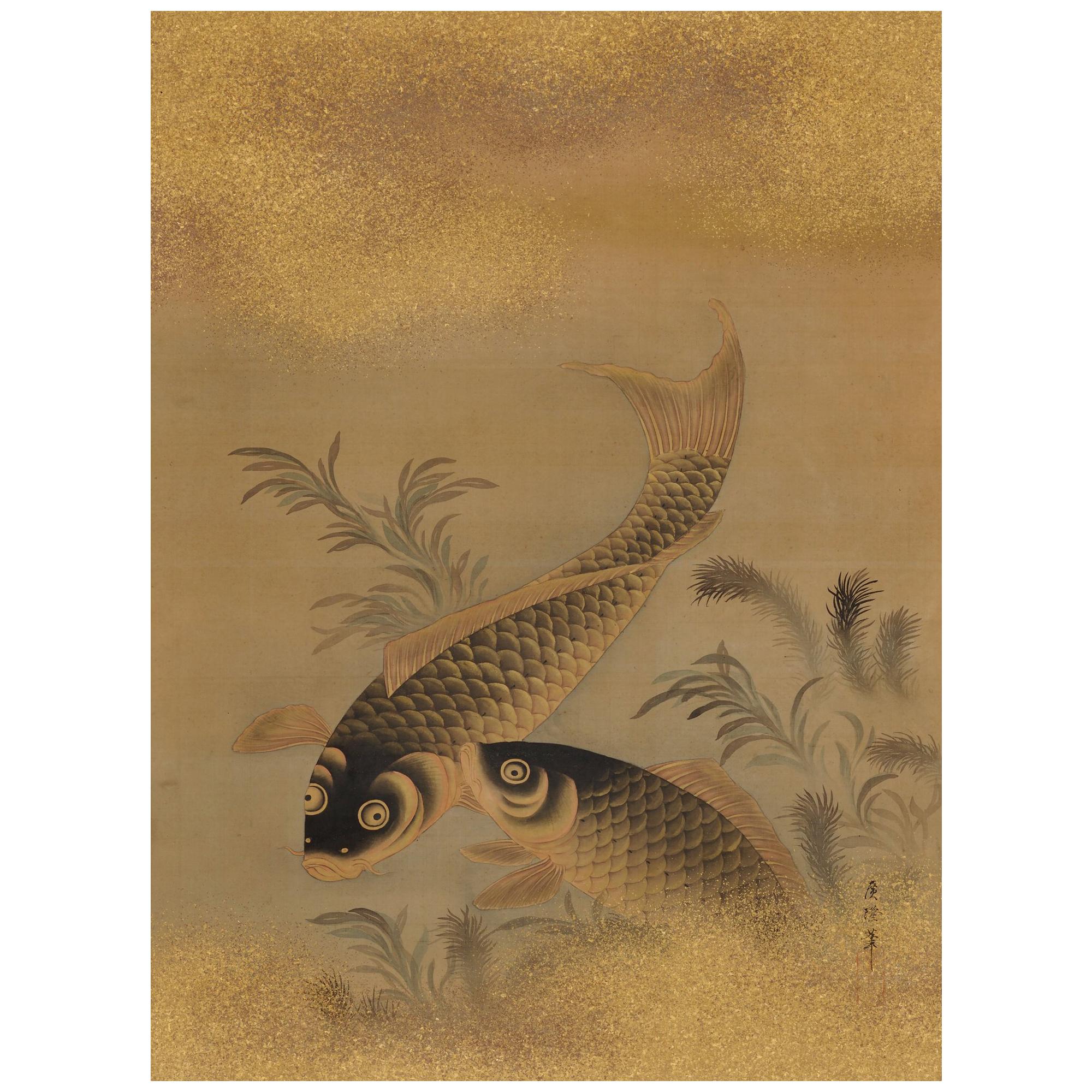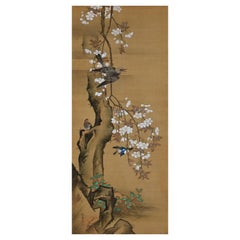
19th Century Japanese Bird and Flower Painting, Pheasants and Peonies
View Similar Items
Want more images or videos?
Request additional images or videos from the seller
1 of 5
19th Century Japanese Bird and Flower Painting, Pheasants and Peonies
About the Item
- Creator:Takakura Zaiko (Artist)
- Dimensions:Height: 39 in (99.06 cm)Width: 16.5 in (41.91 cm)Depth: 0.1 in (2.54 mm)
- Style:Edo (Of the Period)
- Materials and Techniques:
- Place of Origin:
- Period:
- Date of Manufacture:circa 1855
- Condition:
- Seller Location:Kyoto, JP
- Reference Number:1stDibs: LU247238764573
About the Seller
5.0
Recognized Seller
These prestigious sellers are industry leaders and represent the highest echelon for item quality and design.
Established in 2001
1stDibs seller since 2016
61 sales on 1stDibs
Typical response time: 6 hours
More From This SellerView All
- 19th Century Japanese Scroll Painting, Birds & Flowers of the Four SeasonsLocated in Kyoto, JPBirds and flowers of the four seasons Early to mid-19th century Ink, pigment and gofun on silk Unidentified artist Signature: S...Category
Antique 1830s Japanese Edo Paintings and Screens
MaterialsSilk
- 19th Century Japanese Silk Painting by Kano Chikanobu, Pheasants & Plum in SnowLocated in Kyoto, JPBirds & Flowers of the Seasons Pheasants & Plum in Snow Ink, pigment and gofun on silk Kano Chikanobu 1819-1888 Signature: Chikanobu Seal: Shateki Offered here is an unframed ‘kacho-e’ painting by the 19th century Japanese Takamatsu domain painter Kano Chikanobu. There are 8 individual paintings available, which originally would have been part of a set of 12. ‘Kacho-e’ literally means ‘pictures of birds and flowers’. In reality it covers a wide range of natural motifs including birds, fish, insects and small animals in combination with flowers, grasses or trees. The theme has a long history in Japanese painting. It is one of three painting genres, the other two being landscape and figure, which derive from Chinese academic painting classification. As one of the accepted types of painting to be shown in official residences, scenes of birds, flowers and animals were rife with metaphorical reference as well as physical beauty. In these paintings Chikanobu has made conspicuous use of brilliant pigments and meticulous brushwork. The rocks, water, trees, blossoms, and birds are treated as stylized formal elements in a grand design. All of the components contribute to the patterned effect and tactile richness of the surface. Beyond their highly decorative qualities, the subject of some of the paintings are also an allusion to imperial allegiance; the pheasants are symbolic of bravery and steadfastness, peacocks represent divinity and power, and the phoenix paired with paulownia a just and benevolent ruler. Cranes and turtles symbolize longevity, and the lush, full bloom of the peony flower represents wealth and opulence. Paintings of native Japanese birds and flowers were appreciated primarily for their evocation of the seasons and the traditional poetic emotions associated with them. This is the case with the spring scene of cherry blossoms and birds and the winter scene of narcissus, nandina and sparrows. The rich expression of flower and bird paintings...Category
Antique Mid-19th Century Asian Edo Paintings and Screens
MaterialsSilk
- 19th Century Japanese Silk Painting by Kano Chikanobu, Cherry Blossom & BirdsLocated in Kyoto, JPBirds & flowers of the seasons Pheasants & plum in snow Unframed painting. Ink, pigment and gofun on silk Kano Chikanobu 1819-1888 Signature...Category
Antique Mid-19th Century Asian Edo Paintings and Screens
MaterialsSilk
- Japanese Scroll Painting, 19th Century Chinese Pheasants by Yoshizawa SetsuanLocated in Kyoto, JPChinese Pheasants Yoshizawa Setsuan (1809-1889) Hanging scroll, ink and color on silk. Painting inscription: Setsuan Houyou Upper seal: Y...Category
Antique Mid-19th Century Asian Meiji Paintings and Screens
MaterialsSilk
- Early 19th Century Japanese Screen. Cherry Blossom & Pheasants by Mori TetsuzanLocated in Kyoto, JPMori Tetsuzan (1775-1841) Pheasants and Cherry Blossoms Two-fold Japanese screen. Ink, color, gofun, gold and silver on paper. A two-fold Japanese bir...Category
Antique Early 19th Century Japanese Edo Paintings and Screens
MaterialsGold Leaf
- Japanese Screen Painting, Early 19th Century, Autumn Flowers by Sakai HoitsuLocated in Kyoto, JPA two-fold Japanese screen by the Rimpa school artist Sakai Hoitsu (1761-1828), Japan, 19th century, Edo period. This small Japanese folding screen pai...Category
Antique Early 19th Century Japanese Edo Paintings and Screens
MaterialsWood, Silk
You May Also Like
- 1979 Cui Tang Chinese Pheasants Love Birds Painting on Silk Flowers PeoniesLocated in Dayton, OH1979 Cui Tang Chiense / Korean painting on silk showing brightly colored male and female pheasants in front of a bush of pink and white peonies. 1 ?? huà tí Title of the Art 2 ?? (Korean) N/A 1. gold thread 2. marital relationship 3 ?????? ? yi jiu qi jiu nián dù zuò Work in the year of 1979 4&5 ?? cuì táng Cui Tang (?: green; ?:chamber) (artist’s pseudonym/esteemed name) This art was made in 1979...Category
Vintage 1970s Chinoiserie Paintings and Screens
MaterialsSilk, Paint
- Japanese Antique Ink Painting / 19th Century / Rare Chinese Character PaintingLocated in Sammu-shi, ChibaWe have a unique Japanese aesthetic sense. And only we can introduce unique items through our purchasing channels in Japan and the experience we have gained so far, in such a way that no one else can imitate. It is an ink painting written after the Meiji era. The biggest attraction of this work is that it uses Chinese characters to create paintings. To explain in detail, it is written here in Chinese characters as "un-ryu" . "Un" is a cloud and "ryu" is a dragon. These are embodied and drawn by comparing them to the meaning of Chinese characters. And the clouds depict the clouds hanging over the mountain, and the dragon depicts the climbing toward the mountain. Humorous paintings...Category
Antique Late 19th Century Japanese Edo Paintings
MaterialsAcrylic, Paper
- Japanese Two-Panel Screen Peony and CherryLocated in Hudson, NYJapanese two-panel screen: Peony and Cherry, Edo period (circa 1800) painting, formerly fusuma (Japanese sliding doors), executed in the Kano school style, featuring a cherry tree in...Category
Antique Early 1800s Japanese Edo Paintings and Screens
MaterialsGold Leaf
- Edo Period 19th Century Japanese Folding Screen Six Panels Flowers on Gold LeafBy Rimpa SchoolLocated in Brescia, ITClouds of gold, water and many colorful flowers: Japanese six-panel folding screen by Rimpa School. Hand painted with rice mineral pigments and inks on rice paper and gold leaf.Category
Antique Early 19th Century Japanese Edo Paintings and Screens
MaterialsGold Leaf
- Set of 6 Large Kakemonos Japanese Mythology, 19th Century Japan circa 1800 EdoLocated in Beuzevillette, FRBeautiful set of 6 large kakemonos from 19th century Japanese mythology. Paper support with a canvas pasted on the paper Wonderful set that is part of Japan's history and beliefs When not hung, the Kakemonos are rolled up. circa 1800 - Japan - Edo Period A kakemono translates as "object to hang". In Japan this refers to a painting or calligraphy, most often done on silk or paper framed in a scroll that was intended to be hung on walls or in public lighting. This particular form, which allows them to be in a roll, dates back to the Tang dynasty in China (this would be related to the copying and preservation of ancient Buddhist texts). A Kami is a deity or spirit worshipped in the Shinto religion. A Yokai is a spirit, ghost, demon, or strange apparition from the creatures of Japanese folklore. Each of these kakemonos represents a unique story: - A kami, a Japanese deity, is shown painting a rainbow. Indeed, he performs the action with his right hand while his left hand holds a kind of basket with three pots of paint. This kami has a rather closed attitude. He is standing in a dark and tormented sky. Below this figure, 8 villagers are dressed in traditional Japanese clothes. Their faces are softened. They are not afraid of the elements made by the kami above their heads. - A character with an unreal look is holding a kind of jar with his two hands, which he spills on human figures above. This being is floating in the air, probably a character from mythology, perhaps Susanoo. Underneath, villagers on umbrellas. They are trying to protect themselves as best they can from what is falling on them. One of them is carrying baskets with fish on her shoulders. A character in the background is thrown forward and falls. - On this kakemono, the god Raijin, dressed in a white and blue outfit, strikes the sky with his two drum hammers to create lightning and its thunderous sound. Surrounded by Tomoe and a long red scarf, Raijin, enraged and with dishevelled hair, creates a dark and violent storm. The villagers seem frightened by this meteorological phenomenon. One of the villagers can be seen fainting in the arms of a man. This scene may seem chaotic, but Japanese legend tells us that once a field is struck by lightning, the harvest is good. - On this kakemono, we see an unreal-looking figure holding a fan, as if he were sweeping away the bad weather, or simply producing gusts of wind. He is probably the kami of wind and air, Shina tsu-hiko. The figures below him seem surprised by so much wind. An umbrella flies away on the left, the women hold their hair and scarf, the clothes are caught in the power of the wind, there is even a woman on the ground on the bottom left. - This Kakemono represents a short moment. This Raiju is a yokai (ghost spirit...Category
Antique 19th Century Japanese Edo Paintings
MaterialsPaper
- Pair of Antique Japanese Flower Paintings by Yanagisawa Kien, circa 18th CenturyBy Yanagisawa KienLocated in Prahran, VictoriaPair of antique Japanese Nagasaki School paintings by Yanagisawa Kien (1704-1758), depicting classical ikebana flower arrangements. Each painted on silk in mineral pigments and beari...Category
Antique Mid-18th Century Japanese Edo Paintings and Screens
MaterialsSilk
Recently Viewed
View AllMore Ways To Browse
Silk Peonies Flowers
Chinese Silk Painting Birds
Chinese Classical Painting
Chinese Silk Painting Of Birds
Kyoto Silk Painting
Scholar Seal
Kano School Artist
Temple Of Flora
The Temple Of Flora
Japanese Screen Court
Chinese Scholar Seal
Tosa School
Japanese Tosa School
Antique Hara
Maruyama Okyo
Antique Hand Carved Screen
Japan Folding Screens
Japanese Folding Screen Screen

